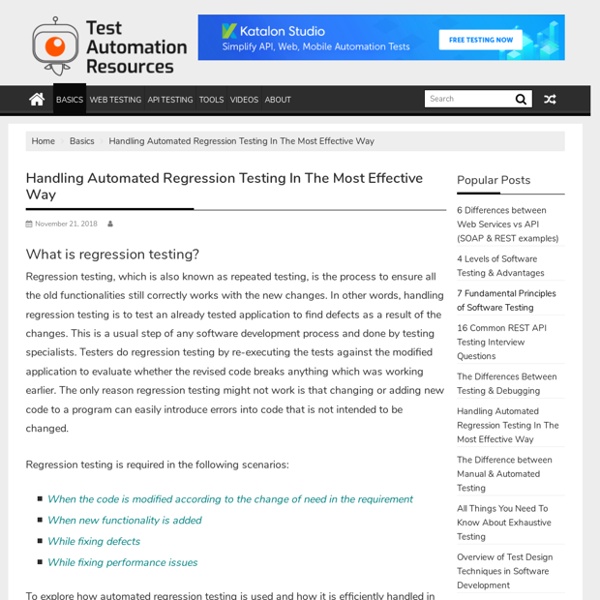



https://testautomationresources.com/software-testing-basics/automated-regression-testing/
Related: allanwalker • kornelia203 • brian2209Getting Started with REST API & RESTful Web Services Testing REST API & RESTful web services explained REST API, which stands for representational state transfer application programming interface. Some of the simplest questions that might come up when you’re first starting to understand REST API is, what is being represented exactly, what is a state, and what is being transferred. So here in the article, let’s look at all these words individually and learn what they all mean. Software Test Automation Engineer Salary and Career Overview in 2019 In this article, I will show you why gaining test automation skills are needed for your quality assurance career if you want to remain marketable as a tester. I will tell you what technical skills and automation tools you need to learn about if you’re just getting started with test automation. Why you should be an automation tester? Automation testing is not a new concept in the software development industry anymore, but it is still one of the fastest growing trends.
What is CI/CD? Continuous Integration & Continuous Delivery CI/CD is the acronym for the combined practices of Continuous Integration (CI) and Continuous Delivery (CD). CI/CD practices are currently the most widely accepted choice to shorten software development and delivery cycle time. In today’s ever-evolving landscape, one of the top challenges for software companies is quickly responding to market and customer demands. The Difference between Manual & Automated Testing In the previous article, we already learned about Software Testing in general (Software Testing Introduction, Software testing type). Software testing is a huge picture with many pieces, but people nowadays tend to categorize it into 2 main types: Manual Testing & Automated Testing. This article will show you “The difference between Manual & Automated Testing” and “Why early apply Automation is worth the effort”. 1. What is Manual Testing? Manual testing is a process of finding defects in the software manually.
Introduction to Continuous Testing Customers nowadays expect top-notch software for their businesses or personal use. To accommodate that need, software companies are incorporating Continuous Testing practices to ensure the software they release to market can outshine the competition. What is Continuous Testing? Continuous Testing is a software testing type in which the product is evaluated early, often, and throughout the entire Continuous Delivery (CD) process.
Katalon Studio Does your business plan include a continuous testing strategy? Is continuous testing right for your organization? Every company who has implemented continuous testing had to answer these questions – and not all companies are able to do so. It requires a strategic planning process and many changes would need to be put in place, which can be challenging for small and large organizations alike. What is End-to-End (E2E) Testing? End-to-End Testing: What is it? End-to-end testing is a technique that tests the entire software product from beginning to end to ensure the application flow behaves as expected. It defines the product’s system dependencies and ensures all integrated pieces work together as expected. The main purpose of End-to-end (E2E) testing is to test from the end user’s experience by simulating the real user scenario and validating the system under test and its components for integration and data integrity. Software systems nowadays are complex and interconnected with numerous subsystems. If any of the subsystems fails, the whole software system could crash.
The Essential Guide To API Testing Overview API testing, or Application Programming Interfaces testing is a kind of software testing that involves verifying and validating APIs and Web services. It’s also a part of integration testing which determines whether the developed APIs meet the tester’s pre-established expectations, such as functionality, reliability, performance, or security. Apply Shift-Left Testing Approach to Continuous Testing As the demand to release quality software products in the short amount of time continues to accelerate, Agile and DevOps teams have to adopt new approaches to avoid falling behind. Continuous testing and shift-left testing are two breakthrough solutions in this modern era of software delivery. In this blog, we will walk you through these two notions, their benefits, and how to implement them into your software development life cycle (SDLC). What is Continuous Testing? Continuous testing uses a procedure of testing early and often throughout the development lifecycle. Incorporating continuous testing into your organization’s testing strategy accelerates your time-to-market but keeps (or even improves) the quality your customers expect.
Top 10 Benefits of Continuous Integration & Continuous Delivery Continuous Integration (CI) allows you to continuously integrate code into a single shared and easy to access repository. Continuous Delivery (CD) allows you to take the code stored in the repository and continuously deliver it to production. CI/CD creates a fast and effective process of getting your product to market before your competition as well as releasing new features and bug fixes to keep your current customers happy. If you are new to CI/CD, check out the article: Complete Introduction to CI/CD In this blog, we’re going to delve into the top 10 Benefits of Continuous Integration and Continuous Delivery to help you decide if this is the right step for your organization to take. Top 10 Benefits of Continuous Integration and Continuous Delivery
What are Microservices? A Complete Introduction for Beginners Microservices are a type of architectural style for building software that has been gaining popularity. The concept was first introduced at a tech conference in 2011 and has been adopted by many Agile enterprises such as Netflix, Amazon, Uber, SoundCloud, Groupon, eBay, to name a few. So, what are microservices? What are the benefits of microservices?